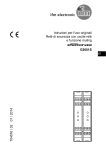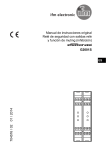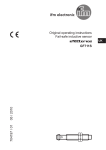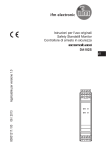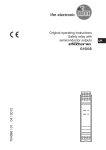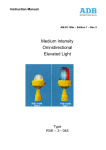Download 704576 / 02 01 / 2014 Original operating instructions Safety
Transcript
Original operating instructions Safety relay with relay outputs and muting function 704576 / 02 01 / 2014 G2001S UK Contents 1 Preliminary note���������������������������������������������������������������������������������������������������4 1.1 Symbols used������������������������������������������������������������������������������������������������4 1.2 Warning signs used���������������������������������������������������������������������������������������4 2 Safety instructions�����������������������������������������������������������������������������������������������5 3 Items supplied�����������������������������������������������������������������������������������������������������5 4 Functions and features����������������������������������������������������������������������������������������6 4.1 Requirements for the hardware configuration�����������������������������������������������6 4.1.1 Product-independent requirements������������������������������������������������������6 4.1.2 Product-dependent requirements���������������������������������������������������������6 5 Structure and operating principle�������������������������������������������������������������������������7 5.1 Connections and indicators���������������������������������������������������������������������������7 5.1.1 Connections������������������������������������������������������������������������������������������7 5.1.2 LED displays�����������������������������������������������������������������������������������������7 5.1.3 LED states��������������������������������������������������������������������������������������������8 6 Installation�����������������������������������������������������������������������������������������������������������9 7 Electrical connection��������������������������������������������������������������������������������������������9 7.1 Supply voltage�����������������������������������������������������������������������������������������������9 7.2 Automatic or manual operation / feedback contacts������������������������������������10 7.3 Muting���������������������������������������������������������������������������������������������������������� 11 7.4 Timeout��������������������������������������������������������������������������������������������������������12 7.5 Override�������������������������������������������������������������������������������������������������������13 7.6 Safety light curtains / light grids�������������������������������������������������������������������13 7.7 Output circuit�����������������������������������������������������������������������������������������������14 7.8 Overview������������������������������������������������������������������������������������������������������15 8 Operating modes�����������������������������������������������������������������������������������������������17 8.1 Automatic operation�������������������������������������������������������������������������������������17 8.2 Manual operation�����������������������������������������������������������������������������������������17 8.2.1 Restart������������������������������������������������������������������������������������������������17 8.3 K1/K2 feedback contacts ����������������������������������������������������������������������������17 8.4 Muting����������������������������������������������������������������������������������������������������������18 8.4.1 Alignment of 2 muting sensors�����������������������������������������������������������19 8.5 Override�������������������������������������������������������������������������������������������������������21 8.5.1 Override with continuous command���������������������������������������������������21 2 8.5.2 Override with command pulse������������������������������������������������������������22 9 Scale drawing����������������������������������������������������������������������������������������������������22 10 Technical data��������������������������������������������������������������������������������������������������23 11 Fault diagnoses �����������������������������������������������������������������������������������������������24 12 Maintenance, repair and disposal��������������������������������������������������������������������25 13 Tests/approvals������������������������������������������������������������������������������������������������25 14 Terms and abbreviations����������������������������������������������������������������������������������26 3 UK 1 Preliminary note The instructions are part of the unit. They are intended for authorised persons according to the EMC and low voltage directives and safety regulations. The instructions contain information about the correct handling of the product. Read the instructions before use to familiarise yourself with operating conditions, installation and operation. Adhere to the safety instructions. 1.1 Symbols used ► Instruction > Reaction, result → Cross-reference LED off LED on LED flashes Important note Non-compliance can result in malfunctions or interference. Information Supplementary note. 1.2 Warning signs used WARNING Warning of serious personal injury. Death or serious irreversible injuries may result. 2 Safety instructions • Follow the operating instructions. • In case of non-observance of instructions or standards, especially when tampering with and/or modifying the unit, any liability and warranty is excluded. • The unit must be installed, connected and put into operation by a qualified electrician trained in safety technology. • The applicable technical standards for the corresponding application must be complied with. 4 • For the installation the standards EN 60204, EN 999 and ISO 13855 have to be adhered to (the response times of all safety components have to be observed). • In case of malfunction of the unit please contact the manufacturer. Tampering with the unit is not allowed. • Disconnect the unit externally before handling it. Also disconnect any independently supplied relay load circuits. • After setup the system has to be subjected to a complete function check. • Use the unit only in specified environmental conditions (→ 10 Technical data). In case of special operating conditions please contact the manufacturer. UK WARNING In case of improper handling of the product, the safety and physical integrity of operators and machinery cannot be guaranteed. Death or serious irreversible injuries may result. ►► Observe all notes on installation and handling in these instructions. ►► The safety relay must only be used under the specified operating conditions and in accordance with use as prescribed below. 3 Items supplied • 1 G2001S safety relay • 1 copy of the operating instructions safety relay, reference 704576. If one of the above-mentioned components is missing or damaged, please contact one of the ifm branch offices. 5 4 Functions and features The G2001S safety relay is a redundant system and suited for use as muting relay in conjunction with 2 or 4 muting sensors. ifm electronic gmbh assumes no liability for the use of units made by external manufacturers. The safe state is when the output contacts (12/22 or 23/24) are open. 4.1 Requirements for the hardware configuration The following requirements must be met when using the G2001S safety relay: 4.1.1 Product-independent requirements It must be ensured that the safety requirements of the respective application correspond to the requirements stated in these instructions. The specified technical data indicated in these instructions must be complied with. 4.1.2 Product-dependent requirements The safety relay is only to be used for muting applications in conjunction with safety light curtains / light grids. The response times of all safety components are to be considered (e.g. safety light curtains / light grids). In case of faults within the safety relay which result in the defined safe state, the safety relay must be replaced. Any faulty unit should be returned to the manufacturer. 6 5 Structure and operating principle 5.1 Connections and indicators 1 4 2 5 3 6 13 15 16 17 18 S1 IN S2 FAIL MUT. GUARD BREAK 7 8 9 10 11 12 UK 19 20 21 22 23 24 5.1.1 Connections 1 2 3 4 5 6 7 8 9 Muting sensor S1 Muting sensor S2 Supply voltage L+ Timeout 1 Timeout 2 Operating mode MAN/AUTO Override 1 Override 2 n. c. 13 14 15 16 17 18 19 20 21 Supply voltage LPE (GND) Restart n. c. Input OSSD 1 Input OSSD 2 n. c. Feedback contact K1/K2 Auxiliary output 10 Muting lamp 22 Relay output R2 11 Muting activation 23 Relay output R1 12 Relay output R2 24 Relay output R1 5.1.2 LED displays S1 yellow status muting sensor S1 S2 yellow status muting sensor S2 MUT. yellow muting status IN FAIL GUARD BREAK green red green / red / yellow status OSSDs failure status relay output R1/R2 7 5.1.3 LED states Description S1 IN S2 FAIL MUT. GUARD BREAK LED S1 S2 MUT. yellow yellow yellow / / Switch-on test Object detected No object detected Muting active Override request Description S1 IN S2 FAIL MUT. GUARD BREAK Switch-on test Protected area interrupted, relay outputs deactivated Protected area clear, relay output deactivated, waiting for restart Protected area clear, relay outputs activated 8 LED IN FAIL green red GUARD/BREAK red yellow green 6 Installation Mount the unit on a DIN rail in a housing protected against dust and humidity (min. IP 54 - degree of soiling 2). Leave enough space between the unit and the top and bottom of the housing to enable air circulation and to avoid excessive heating. Take into account the internal heating of all units when mounting several units side by side. The environmental conditions must be observed for every unit. 7 Electrical connection UK ►► Disconnect power. Also disconnect any independently supplied relay load circuits. Note: Lay the safety relay cables separately from sources of interference such as power lines. Connection cables between safety relay and safety light curtains /light grids of a length of more than 50 m must have a cross-section of min. 1 mm². The safety relay is only to be used for muting applications in conjunction with safety light curtains / light grids. 7.1 Supply voltage The nominal voltage is 24 V DC. This voltage may vary between 19.2 V and 28.8 V incl. 5% residual ripple. SELV /PELV power supplies are to be used. Connect supply voltage L+ L 3 13 Manual reset L+ L 3 13 For safety reasons the unit can only be restarted by separation from the supply voltage in case of a fault. It is thus recommended to install a reset button in series with the L+ circuit. 1: Reset 9 After power on or a reset the unit carries out self diagnostic functions. After this self diagnosis the unit is ready for operation. 7.2 Automatic or manual operation / feedback contacts Automatic operation Automatic activation without monitoring. L+ L 15 6 Automatic operation with monitoring of the feedback contacts L+ L 15 6 Release is made when the feedback contacts are closed. Consider the current flowing through the feedback contacts (→ 10 Technical data). 20 1: Feedback contacts Manual operation L+ L 15 6 1: Restart 10 Activate the relay outputs: ►► Press and release restart (> 100 ms). Manual operation with monitoring of the feedback contacts Activate the relay outputs: The feedback contacts are closed ►► Press and release restart (> 100 ms). L+ L 15 6 Consider the current flowing through the feedback contacts (→ 10 Technical data). 20 1: Restart 2: Feedback contacts UK ►► If no feedback contacts are used, connect terminals 20 and 21. 7.3 Muting Connection of 2 muting sensors Muting sensor S1 L+ L Muting sensor S2 L+ L 1 2 Alignment of the muting sensors → 8.4.1 Connection of 4 muting sensors L+ L L+ L 1 2 11 Muting lamp L+ L 10 Prerequisite for the muting function is the connection of a muting lamp (0,5...5 W). Muting activation L+ L 11 To start the muting function a high signal (24 V) has to be applied to terminal 11. A continuous signal or a pulse > 1 s can be used. 7.4 Timeout Timeout is a time limit of the muting function. Timeout 30 seconds The muting function ends after 30 s. L+ L 4 5 Unlimited timeout L+ L 4 When the muting function has started it is available for an unlimited period of time as long as the muting sensors detect an object. 5 If unlimited timeout is used, additional measures are to be taken to avoid a permanent muting function. 12 7.5 Override Do not short-circuit terminals 7 and 8. Override with continuous command L+ L 7 ►► Use a key-operated switch with spring return. The command pulse must be applied simultaneously to both terminals within 400 ms. 8 UK 1: Key-operated switch Override with command pulse L+ L 7 The command pulse must invert the condition of terminals 7 and 8 within 400 ms. 8 1: Override button 7.6 Safety light curtains / light grids Do not short-circuit terminals 17 and 18. 17 18 ►► Connect the OSSD signals to terminals 17 and 18. 13 7.7 Output circuit Connect the load ►► Connect the load to be controlled to the relay outputs 23/24 or 12/22. L+ L K1 12 For the output circuit, the G2001S uses two guided contact safety relays. 22 ►► Protect the output contacts with a slow-acting 3,6 A fuse. 24 Check if the loads correspond to the values in the table below. Min. voltage > 18 V DC Min. current > 20 mA Max. voltage < 250 V AC Max. current <2A 3,6 A L+ L K2 3,6 A 23 21 Input SPS The auxiliary output (terminal 21) provides a non safety-related signal for communication to a PLC. The signal corresponds to the relay outputs 23/24 or 12/22. Check the proper function of the entire safety system (safety relay and safety light curtains / light grids) after electrical connection. ►► Interrupt the protected area of the safety light curtain / light grid >> Relay outputs of the G2001S drop out → 5.1.3 LED states (GUARD/BREAK) 14 7.8 Overview Automatic operation with monitoring of the feedback contacts and timeout 30 s L+ L 1 Sensor 1 0 V DC 13 2 Sensor 2 PE 14 3 24 V DC Restart 15 4 Timeout 1 n. c. 16 5 Timeout 2 Input OSSD 1 17 6 MAN/AUTO Input OSSD 2 18 7 Override 1 n. c. 19 8 Override 2 K1/K2 feedback 20 9 n. c. Auxiliary output 21 10 Muting lamp 22 11 Muting enable 23 12 24 K1 UK *) K2 1: K1/K2 feedback contacts *) If no feedback contacts are used, connect terminals 20 and 21. 15 Manual operation with monitoring of the feedback contacts and timeout 30 s L+ L 1 Sensor 1 0 V DC 13 2 Sensor 2 PE 14 3 24 V DC Restart 15 4 Timeout 1 n. c. 16 5 Timeout 2 Input OSSD 1 17 6 MAN/AUTO Input OSSD 2 18 7 Override 1 n. c. 19 8 Override 2 K1/K2 feedback 9 n. c. 20 *) Auxiliary output 21 10 Muting lamp 22 11 Muting enable 23 12 24 K1 1: K1/K2 feedback contacts K2 2: Restart button *) If no feedback contacts are used, connect terminals 20 and 21. 16 8 Operating modes After new installation or change of the operating mode check the function of the entire safety system (safety relay and safety light curtains / light grids). 8.1 Automatic operation If the safety relay is used in the automatic mode, monitored start is not possible. The safety light curtains / light grids automatically return to operation if the protected area is clear, the relay outputs (OSSDs) are activated. Verify if this is compatible with your machine. UK In the automatic mode the relay 1 and relay 2 outputs follow the status of the safety light curtains / light grids: Protected area clear Protected area interrupted Relay outputs = active logic "1" Relay outputs = deactived logic "0" 8.2 Manual operation Operation in the manual mode is always necessary when passage to a hazardous area is to be monitored (persons can be present in the hazardous area after accessing the protected area without being detected). The relay 1 and relay 2 outputs become active when the protected area is clear and restart is activated via a restart button or via a respective pulse (> 100 ms) on the input of terminal 15. If the safety light curtains / light grids are activated by a person or an object, a restart is always necessary for the release. 8.2.1 Restart The restart button has to be outside the hazardous area It has to be installed so that the hazardous area and access can be clearly seen. It must not be possible to activate the restart button from within the hazardous area. The restart time of the safety relay is 100 ms. Also take into account the restart times of the external contactors. 17 8.3 K1/K2 feedback contacts External contactors can be integrated into the automatic or manual operation. They must be connected to terminal 20 (K1/K2 feedback contact). For loads of voltages and currents higher than those indicated in the following table external contactors or auxiliary relays should be used in accordance with the loads to be switched. Safety elements with positively guided contacts are to be used. Min. voltage Min. current Max. voltage Max. current ≥ 18 V DC ≥ 20 mA ≤ 250 V AC ≤2A If no external contactors are used, the terminals 20 (K1/K2 feedback contact) and 21 (auxiliary output) must be interconnected. The auxiliary contacts of K1 and K2 must be able to switch a current of 20 mA and a voltage of 24 V DC. Suitable interference suppressors on the coil end of K1 and K2 prolong the life of the internal relays. 8.4 Muting Muting is the temporary suspension of the protective function of safety light curtains / light grids to transport objects through a hazardous area as planned. The muting sensors detect objects before they enter the protected area and enable a distinction between man and material after correct optical alignment. Check if this function is compatible with the risk analysis of your machine and if additional measures have to be taken. The following components are necessary for the muting function: -- G2001S safety relay -- safety light curtain / safety light grid -- 2 or 4 muting sensors -- muting lamp (0,5...5 W) 18 To start the muting function a high signal (24 V) must be applied to terminal 11 (muting activation) for 1 s. Correct alignment of the muting sensors is imperative for the proper function of the safety relay. 8.4.1 Alignment of 2 muting sensors UK 1: Muting sensor 1 2: Muting sensor 2 3: Reflector 4: Safety light curtain / safety light grid 5: Object 6: Hazardous area • Align the muting sensors so that they can detect objects before they enter the hazardous area. • If an object is detected by both muting sensors S1 and S2 within 4 s, the muting function is active and the object can travel through the hazardous area. • Both muting sensors must carry a high signal (24 V) while the muting function is active. Muting ends with one of the following conditions: -- after release of one of the two muting sensors -- when the time limit of 30 s has elapsed (timeout) 19 Muting ends after release of the muting sensors [V] 24 0 24 0 Muting sensor 1 Muting sensor 2 Time limit Protected area clear interrupted 24 0 24 0 24 0 24 0 Muting Timer 24 0 24 0 Muting enable Relay outputs 4 30 [s] 0,02 Muting ends after the time limit (timeout 30 s) has elapsed [V] 24 0 24 0 Muting sensor 1 Muting sensor 2 Time limit Protected area Muting Timer Muting enable Relay outputs 20 clear interrupted 24 0 24 0 24 0 24 0 24 0 24 0 4 30 [s] 0,02 8.5 Override Override means suspension of the safety function. It ensures a controlled restart to transport jammed material out of the protected area. WARNING During the whole override function access to the hazardous area is not protected by the safety light curtains / light grids. Death or serious irreversible injuries may result. ►► Mind the dangers in the hazardous area. UK When the override function is active, the OSSD outputs of the safety light curtains / light grids are inactive and/or at least one muting sensor detects an object. The MUT. LED lights during the whole override function (→ 5.1.2 LED displays) Regularly check the function of the LED displays. The following types of override can be configured: -- override with continuous command -- override with command pulse 8.5.1 Override with continuous command ►► Activate key-operated switch >> Bridging the safety light curtains / light grids for max. 15 min. The override function ends with the following conditions: -- key-operated switch activated again. -- 15 min. have elapsed. -- protected area clear and muting sensors free. The GUARD function is activated without further commands. 21 8.5.2 Override with command pulse ►► Press override button >> Bridging the safety light curtains / light grids for max. 15 min. The function can be started again by activating the override button at the following conditions: -- max. 30 subsequent override command pulses -- max. total time of the override function = 60 min. The override function ends automatically with clear protected area and free muting sensors or when the 15 min have elapsed and the GUARD function will be activated without any further command. The timer for the override command pulses and the total time of the override function will be reset to 0. 9 Scale drawing 114,5 99 35 LEDs 22 10 Technical data G2001S Safety relay with relay outputs Meets the requirements of: EN ISO 13849-1 (2008) category 4 PL e, SIL 3 (IEC 61508), SILCL 3 (IEC 62061) Electrical design Output function relay 2 safety-related normally open contacts (floating contacts, 2 A / 250 V); 1 signal output (PNP, 100 mA (24V)) 24 V DC (19.2...28.8) 6 A / 250 V AC / 24 V DC ( ≥ 10 mA) *) no UK Operating voltage Contact rating Short-circuit protection / overload protection Current consumption 208 mA (24 V) Safety light curtains / light grids to 1 (with OSSD outputs) be connected Input muting sensors 2 sensors (24 V DC, PNP, dark-on mode) Input muting activation 24 V DC, PNP Output muting lamp 24 V DC / 0,5...5 W Power-on delay time < 12 s Response time on safety request 20 ms Min. load current of the feedback 20 mA (24 V) contacts Current rating auxiliary output max. 100 mA (20 °C) (terminal 21) Ambient temperature 0...55°C Protection rating IP 20 Housing materials PA Mission Time (TM) 175200 h Safety-related reliability PFH 7,0 -9 / h 100 years MTTFd DC / CCF / Cat. 96 % / 80 % / 4 Switching operations 800.000 (2 A (230 V AC) / 0,5 A (24 V DC)) *) The contacts are to be protected by means of fuses with a nominal current of < 3.6 A. 23 11 Fault diagnoses In the event of malfunctions of the module or faulty electrical connections possible causes can be detected by means of flash pulses. In case of a fault switch the safety relay off and on again! S1 IN S2 FAIL MUT. GUARD BREAK Description Wrong connection or muting lamp missing Wrong configuration or muting timeout exceeded Fault of the external relay K1/K2 Error muting sensor Override with command pulse not available Description Internal fault S1 IN S2 FAIL MUT. GUARD BREAK S1 yellow LED S2 yellow MUT. yellow pulses 2 3 4 / / 5 6 LED IN FAIL green red GUARD/BREAK red pulses 2 Fault of the internal relay 3 Fault of the external relay K1/K2 4 Wrong output configuration 5 Configuration changed without restart ►► make a restart Possible overload or wrong connection of the auxiliary output 6 7 If the fault cannot be eliminated, switch off the entire machine and contact the ifm service hotline. 24 12 Maintenance, repair and disposal • Only the manufacturer is allowed to repair the unit. • After use dispose of the unit in an environmentally friendly way in accordance with the applicable national regulations. 13 Tests/approvals The G2001S safety relay was tested and certified by TÜV Süd. The safety relay was developed and tested in accordance with, for example, the following directives and standards: • 2006/42/EC European machinery directive • 2004/108/EC EMC Directive • EN ISO 13849-1 (2006) Safety of machinery, safety-related parts of control systems • IEC 61496 Safety of machinery - Electro-sensitive protective equipment • IEC 62061 Safety of Machinery - Functional safety of safety-related control systems • IEC 61508 Functional safety of safety-related systems UK 25 14 Terms and abbreviations ESPE Electro-Sensitive Protective Equipment Cat. Category CCF Common Cause Failure DC Diagnostic Coverage MTTF Mean Time to Failure MTTFd Mean Time To Dangerous Failure OSSD Output Signal Switching Device PFH (PFHD) Probability of (dangerous) Failure per Hour PL Performance Level PL to EN ISO 13849-1 SIL Safety Integrity Level SIL 1-4 to IEC 61508 PLC Programmable Logic Controller Classification of the safety-related parts of a controller as regards their resistance to failures. Output signal switch element, static safety-related output. Technical data and further information at www.ifm.com → Select your country → Data sheet direct: 26 UK 27



























